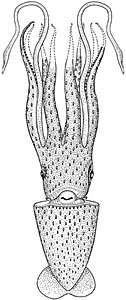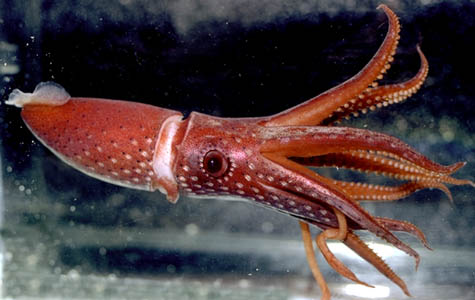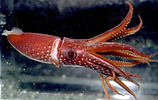Histioteuthis cerasina
Richard E. Young and Michael VecchioneIntroduction
Histioteuthis cerasina appears to be rather common in Central and Eastern Pacific tropical waters.Characteristics
- Photophores
- Head photophores Type 2a (2 photophores in Midline Series, 3 in Basal Arm IV Row).
- Suckers
- Rings on enlarged median suckers of manus with 30-35 equally small, sharp, narrow conical teeth in small squid and 40-60 teeth in large squid.
Comments
More details of the description can be found here.Species of the corona-group are distinguished by the following characteristics:
- Photophores
- Type 2 head-photophore pattern (e.g., 2 Midline Series photophores, 3 or 4 Basal Arm IV Row photophores and no rogue photophore) .
- Basal Row with 7 photophores.
- Right Basal Series present.
- Arms IV without separate series of compound photophores at arm tip.
- Compound photophores on anterior half of ventral mantle uniform in size.
- Arms
- Suckers with smooth rings on arms I-III except at distal ends and occasionally on basal suckers.
- Suckers of arms IV with dentition.
- Tubercles
- Absent
The following table compares differences among members of the corona-group. H. cerasina and H. corona are very similar but occupy different oceans.
| Character | Photophores Arms IV No. of series | Suckers Dentition Manus, large |
|---|---|---|
| H. corona | 3 | 33-38 |
| H. berryi | 4 | 28-34 |
| H. cerasina | 3 | 40-60 |
Except for the analysis of head photophores, this description is from Voss (1969) and Voss, et al. (1998).
Distribution
Geographic distribution
Type locality: Southeastern Pacific, 00°01'S, 84°59'W. H. cerasina is found in the central and eastern equatorial Pacific, and the eastern southern tropical Pacific (Voss, et al., 1998).References
Voss, N. A. 1969. A monograph of the Cephalopoda of the North Atlantic: The family Histioteuthidae. Bull. Mar. Sci., 19: 713-867.
Voss, N. A., S. J. Stephen and Zh. Dong. 1992. Family Histioteuthidae. p. 73-91. In: Sweeney, M. J., C. F. E. Roper, K. M. Mangold, M. R. Clarke and S. V. Boletzky (eds.). "Larval" and juvenile cephalopods: a manual for their identification. Smithson. Contr. Zool., No. 513: 1-282.
Voss, N.A., K. N. Nesis, P. G. Rodhouse. 1998. The cephalopod family Histioteuthidae (Oegopsida): Systematics, biology, and biogeography. Smithson. Contr. Zool., 586(2): 293-372.
Title Illustrations
| Scientific Name | Histioteuthis cerasina |
|---|---|
| Reference | modified from Voss, N. A., S. J. Stephen and Zh. Dong. 1992. Family Histioteuthidae. p. 73-91. In: Sweeney, M. J., C. F. E. Roper, K. M. Mangold, M. R. Clarke and S. V. Boletzky (eds.). "Larval" and juvenile cephalopods: a manual for their identification. Smithson. Contr. Zool., No. 513:1-282. |
| View | ventral |
| Size | 48 mm ML |
| Type | holotype |
About This Page
Richard E. Young
Dept of Oceanography
University of Hawaii
Honolulu, Hawaii 96822
USA
National Marine Fisheries Service
Systematics Laboratory
National Museum of Natural History
Washington, D. C. 20560
USA
Page copyright © 2000 Richard E. Young and
Citing this page:
Young, Richard E. and Vecchione, Michael. 2000. Histioteuthis cerasina . Version 01 January 2000 (under construction). http://tolweb.org/Histioteuthis_cerasina/19803/2000.01.01 in The Tree of Life Web Project, http://tolweb.org/










